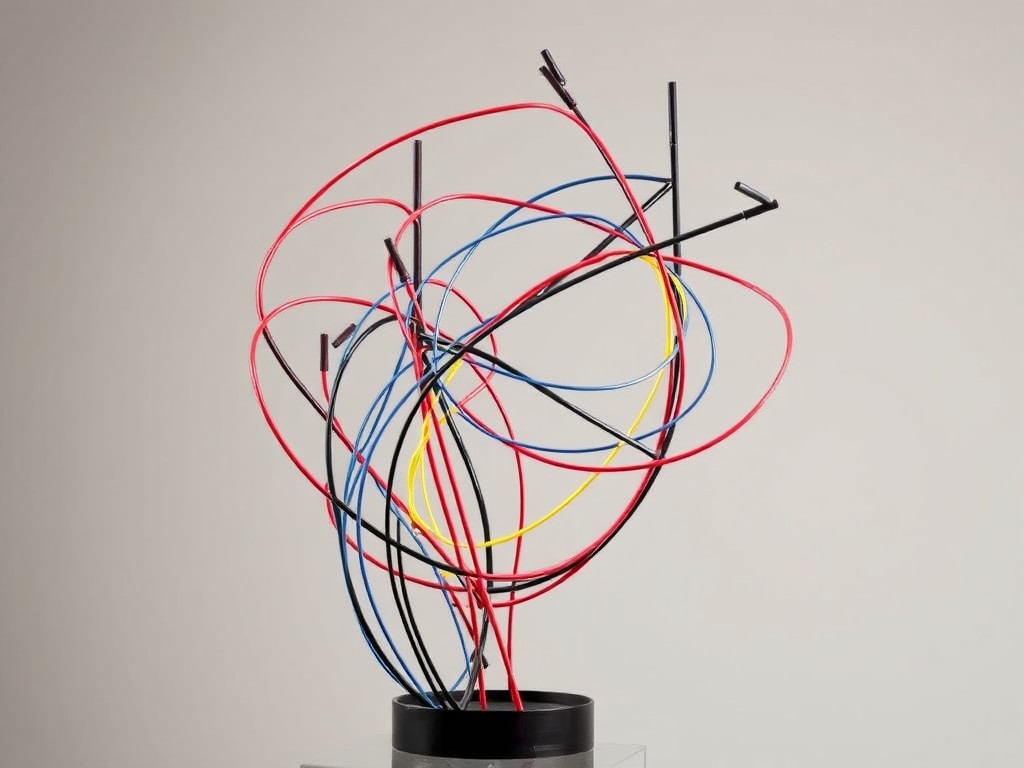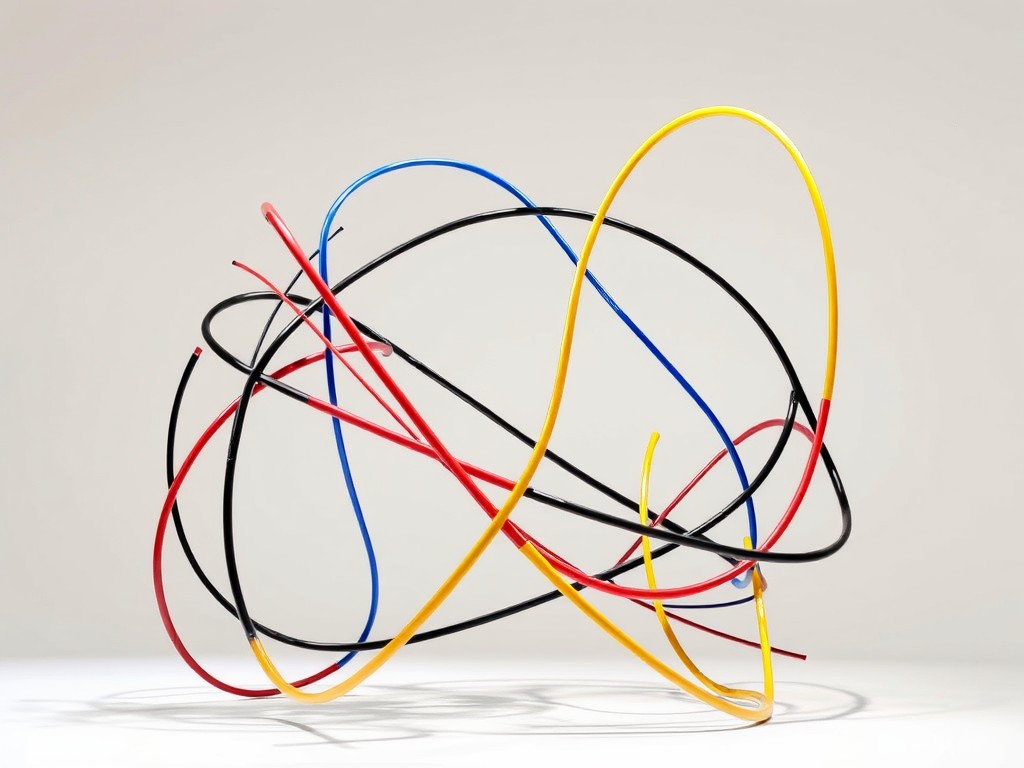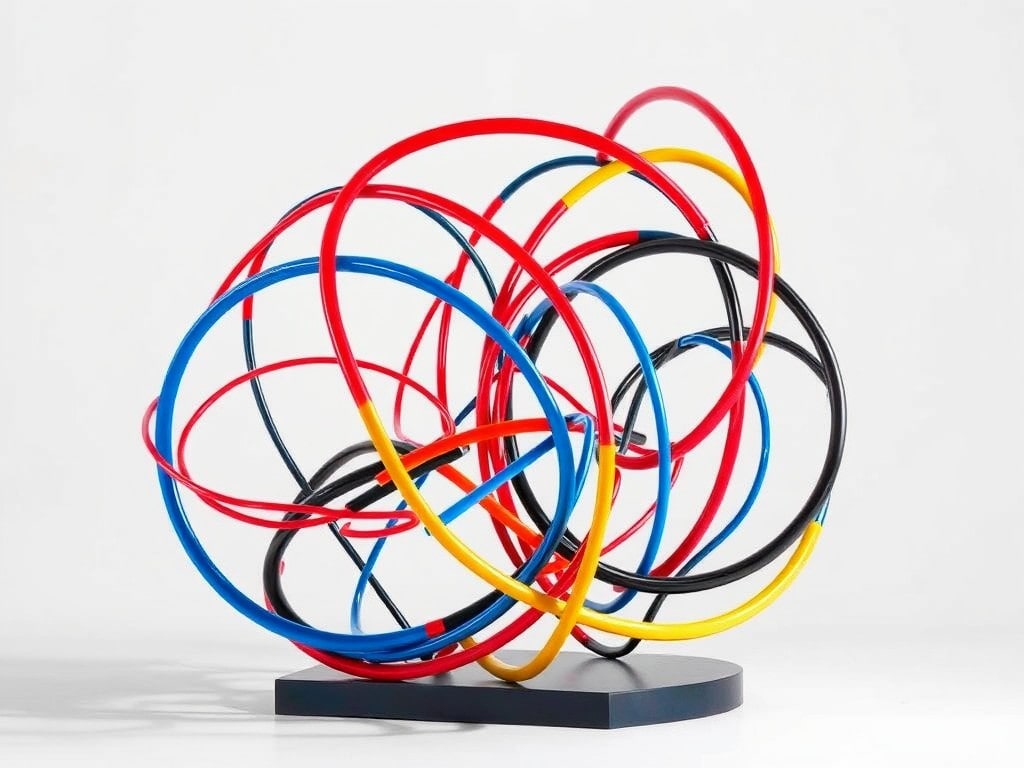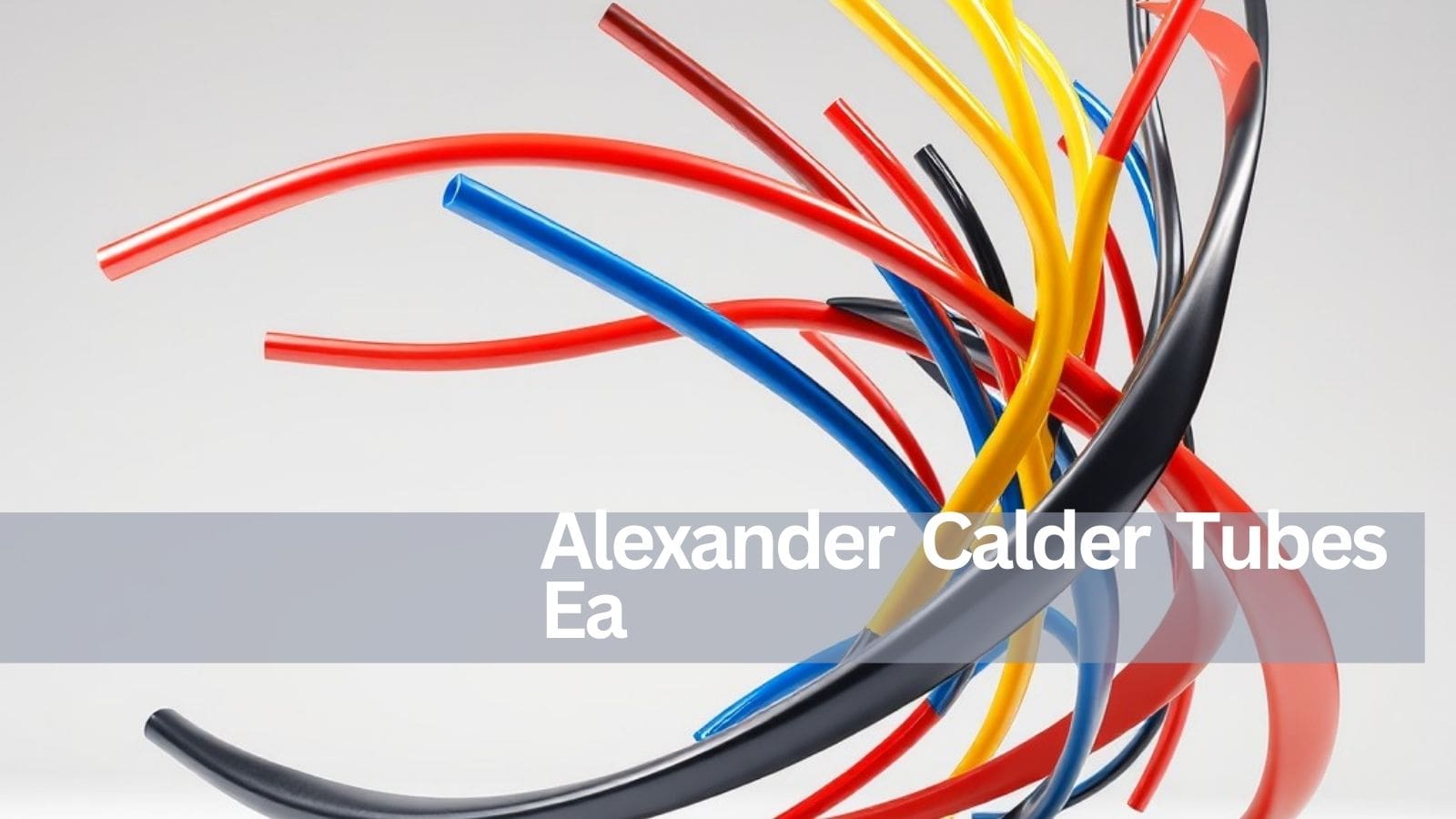Alexander Calder, renowned for his groundbreaking contributions to the world of kinetic sculpture, continues to captivate audiences with his unique blend of art and movement. Among his most iconic works are the Alexander Calder Tubes EA, sculptures that not only display the beauty of motion but also challenge our perceptions of space, form, and color.
This article delves deep into the origins, technical aspects, artistic influence, and modern-day applications of these extraordinary creations.
The Genesis Of Alexander Calder Tubes Ea:

To understand the significance of the Calder Tubes EA, it’s important to first explore the history behind Calder’s fascination with movement in art. Calder’s journey began long before he developed his kinetic sculptures, starting with his early wire sculptures that were influenced by both his childhood experiences and his exposure to nature. His desire to capture motion, which he observed in the world around him, led him to experiment with various materials, eventually arriving at metal tubing as a central medium in his kinetic works.
The Calder Tubes EA evolved out of this experimentation, where Calder combined his technical knowledge with a playful sense of artistic freedom. These pieces are more than just sculptures; they are intricate systems of motion, balance, and color that invite the viewer to engage with the artwork in a dynamic way.
The Technical Mastery Behind Calder Tubes Ea:
One of the most captivating aspects of the Alexander Calder Tubes EA is their seamless integration of art and engineering. Each tube is meticulously crafted, often using lightweight materials that allow for elegant, fluid motion. The tubes themselves are not static objects but are designed to sway and react to their environment, particularly to air currents.
Calder’s innovative use of weighted components and strategic placement of rods creates a delicate balance. This balance, combined with the physics of motion, allows the sculpture to transform with every movement, creating an interactive experience for the viewer. In essence, the Calder Tubes EA are kinetic sculptures where gravity, balance, and the environment come together in a Harmon.
What Materials Are Used In Calder Tubes Ea?
To understand what goes into making Calder Tubes EA, it’s important to look at the materials used. The choice of materials plays a crucial role in the functionality and beauty of these kinetic sculptures. Let’s break it down:
- Metal Tubing: One of the most common materials used in Calder Tubes EA is metal tubing. This lightweight yet sturdy material allows the tubes to maintain their balance while still being flexible enough to sway with movement. Calder’s signature metal tubes are typically hollow, which also contributes to their lightness, making them easier to move and interact with.
- Metal Rods: In addition to tubing, metal rods are often used to support and connect different parts of the sculpture. These rods help maintain the structural integrity of the tubes while still allowing them to sway and shift, creating dynamic movement.
- Plastic: Occasionally, Calder Tubes EA might incorporate plastic components. Plastic is another lightweight material that allows for even more flexibility in the design. It may be used in the creation of certain shapes or to add color to the sculpture, following Calder’s affinity for vibrant hues.
- Wire: Thin, flexible wires are sometimes used to attach the various components, giving the sculpture room to move. These wires allow the pieces to pivot, rotate, or sway with the air currents.
- Paint: Another critical material that adds both function and aesthetics to the sculptures is paint. Calder often used bright, bold colors to accentuate the shapes of his tubes. This use of color brings the sculptures to life, making them not only interactive but visually stimulating as well.
Also read: Spip Doc File 11683.Pdf – A Comprehensive Guide To Spip Documentation!
The Aesthetic And Artistic Impact Of Calder Tubes Ea:
The Calder Tubes EA are not just mechanical marvels; they are expressions of Calder’s artistic philosophy. He believed that art should evoke emotion and create a connection between the viewer and the environment. By using vibrant colors and simple, flowing forms, Calder’s tubes engage the viewer in a visual dialogue, inviting them to reconsider how they perceive the relationship between space, movement, and color.
Artists and designers across various fields, from sculpture to fashion, have drawn inspiration from Calder’s work. His ability to merge simplicity with complexity has left a lasting mark on the world of design, with elements of his kinetic sculptures seen in everything from modern architecture to the flowing silhouettes of clothing designs.
Calder Tubes In Modern Art And Design:
Today, the Alexander Calder Tubes EA continue to influence not only the art world but also the broader design and architecture industries. Their playful, dynamic nature makes them ideal for public spaces, where they serve as interactive focal points that encourage engagement from visitors. In modern art galleries, these kinetic sculptures often serve as eye-catching installations, sparking conversations about the nature of motion in art.
In addition, the rise of biophilic design has led to the integration of Calder Tubes EA into green spaces, where their motion mirrors the fluidity of nature. The incorporation of movement in these spaces provides a sense of tranquility while also celebrating the creative spirit of Calder’s original work.
Impact Of Calder Tubes Ea On Modern Design:

Calder’s Tubes EA have significantly influenced many design fields, including architecture, fashion, and product design, with their emphasis on movement, balance, and fluidity. His work continues to inspire creativity and innovation in modern design today.
Architecture: Movement in Space
Calder’s influence on architecture is evident in designs that embrace balance and movement. Buildings today often feature fluid forms, adaptable structures, and open layouts, all inspired by his approach to integrating motion and dynamic space within architecture.
Fashion: Fluidity in Clothing
Fashion designers incorporate Calder’s fluid, dynamic approach by creating garments that move and adapt. This reflects Calder’s emphasis on fluidity and balance, resulting in clothing that flows, shifts, and engages with the wearer’s movement, adding life to fashion.
Interior Design: Dynamic Spaces
In interior design, Calder’s impact is seen in spaces that focus on interaction and movement. Designers now create dynamic environments where elements change or respond to the space or people, promoting a sense of life and constant evolution in interiors.
Art: Kinetic Sculpture
Calder’s legacy in kinetic sculpture has influenced many artists to incorporate movement into their works. Modern sculptures often move or shift, allowing the viewer to experience a changing and interactive art form that echoes Calder’s groundbreaking kinetic pieces.
Product Design: Interactive Elements
In product design, Calder’s principles of motion and balance are evident in products that are interactive. Items like toys, lamps, and gadgets incorporate dynamic features, encouraging users to engage with them, bringing Calder’s kinetic essence into everyday objects.
The Legacy Of Alexander Calder Tubes Ea In Contemporary Culture

As we reflect on the enduring legacy of Alexander Calder Tubes EA, we recognize how these sculptures continue to push boundaries. Their influence can be seen not only in the fields of sculpture and art but also in modern architecture, product design, and even fashion. Calder’s work challenges traditional views of what art can be, demonstrating how art can be an experience rather than a static object.
By encouraging interaction and engagement, Calder Tubes EA have become symbols of innovation, creativity, and the power of motion. Their timeless nature ensures they remain relevant, inspiring both established and emerging artists around the world.
How To Create Your Own Alexander Calder Tube:
For those inspired by Calder’s work, creating your own version of the Alexander Calder Tube can be a rewarding and educational experience. Here’s a simple guide to help you get started:
Materials Needed:
- Lightweight materials (plastic or aluminum tubing)
- Vibrant paints or colored paper
- Precision cutting tools
- Fishing line or thin wire for assembly
Steps:
- Sketch Your Design: Begin by sketching the shapes you want to create. Think about how each piece will interact with air currents and how they will sway or rotate.
- Cut the Tubes: Carefully cut your materials into the shapes you’ve designed.
- Add Color: Paint or wrap your tubes in vibrant colors to bring them to life, just as Calder did in his works.
- Assemble the Components: Use fishing line or wire to connect the pieces. This will allow them to move freely and fluidly.
- Display Your Creation: Find a place where air currents can animate your piece, such as near an open window or a fan.
Through this process, you can better understand Calder’s artistry and the joy of creating kinetic works that explore the intersection of art and physics.
What Is The Significance Of Alexander Calder’s Kinetic Art?
Calder’s kinetic art, such as his Tubes EA, was groundbreaking because it combined motion and sculpture. Unlike traditional sculptures, his work brought static art to life, making it more interactive. The pieces move in response to air currents, engaging viewers in a new way.
Additionally, Calder’s innovative use of motion invited people to experience art not just visually but physically. This shift in art forms set the foundation for future art movements, blending engineering with artistic expression. As a result, Calder’s art continues to inspire creativity and innovation in the modern world.
What Makes Calder Tubes Unique Compared To Other Sculptures?
| Aspect | Calder Tubes | Traditional Sculptures |
| Movement | Incorporates movement, responding to air currents. | Static, no movement; appeal is visual and form-based. |
| Design Focus | Focus on balance, fluidity, and interaction with space. | Focus on form, beauty, and emotional resonance. |
| Materials | Lightweight materials like metal tubing and rods. | Heavy materials like stone, marble, or bronze. |
| Viewer Interaction | Engages viewers through movement, creating a dynamic experience. | Viewer interaction is more passive, mainly visual. |
| Artistic Influence | Combines art and engineering, influencing kinetic art. | Tends to follow traditional artistic styles and themes. |
| Evolution Over Time | Constantly evolving as it moves, creating a changing experience. | Static, unchanging form over time. |
This table clearly outlines the differences between Calder Tubes and traditional sculptures in terms of movement, design focus, materials, and viewer interaction. Calder Tubes stand out due to their dynamic, ever-changing nature, which offers a unique experience to the viewer.
What Impact Did Calder Tubes Have On The Development Of Kinetic Art?
Calder Tubes had a huge impact on the development of kinetic art. These sculptures were revolutionary because they combined art with movement, encouraging other artists to explore how motion could be part of their work. As a result, Calder’s creations helped to shape the future of kinetic art, where motion became a central element in many artistic practices.
Additionally, his work showed how art could be brought to life through engineering, opening new possibilities for combining different creative fields. This paved the way for more artists to experiment with interactive, dynamic sculptures, influencing a wide range of modern art forms.
FAQ’S
1. How did Alexander Calder’s childhood influence his art?
Calder’s childhood played a key role in shaping his creative mind. His early experiences with mechanical toys and exploring nature inspired his fascination with movement, which later influenced his kinetic sculptures like the Tubes EA. His playful curiosity about how things moved naturally carried over into his art.
2. What is the connection between Alexander Calder and modern architecture?
Calder’s work, particularly the Tubes EA, had a strong influence on modern architecture. Architects began to embrace the idea of incorporating movement and balance into their designs, inspired by Calder’s sculptures that blended art and engineering.
3. Are Calder Tubes displayed in public spaces?
Yes, many Calder Tubes are displayed in public spaces worldwide. These interactive sculptures invite people to engage with them, moving in response to wind or touch. They are often placed in parks, museums, or urban environments where passersby can appreciate their dynamic nature.
4. Can Calder Tubes be considered a form of modern technology?
While not a form of technology in the traditional sense, Calder Tubes blend artistry with mechanical principles. They incorporate motion and balance, concepts often explored in engineering, making them a fascinating intersection of art and modern technology.
5. How do Calder Tubes influence contemporary artists?
Contemporary artists are inspired by Calder’s Tubes, using movement in their sculptures and installations. His focus on balance, color, and motion has encouraged modern artists to experiment with new materials and interactive designs that bring art to life.
6. How do Calder Tubes reflect the natural world?
Calder Tubes often reflect the natural rhythms of the world. Their swaying motion imitates the flow of wind or the movement of plants, creating a sense of harmony with nature. This organic influence was central to Calder’s artistic vision.
Conclusion
The Alexander Calder Tubes EA exemplifies the profound intersection of art, movement, and innovation. These kinetic sculptures revolutionized the art world by incorporating motion and influenced various design fields such as architecture, fashion, and product design.
Calder’s work continues to inspire contemporary artists and designers, proving the lasting impact of his dynamic, interactive creations. The Calder Tubes stand as a testament to how art can challenge traditional boundaries and engage viewers in new, exciting ways.










